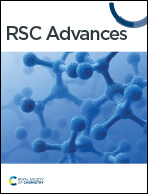Self-healing amino acid-bearing acrylamides/n-butyl acrylate copolymers via multiple noncovalent bonds†
Abstract
Four amino acid-bearing acrylamides, N-acryloyl-L-threonine (AThrOH), N-acryloyl-L-glutamic acid (AGluOH), N-acryloyl-L-phenylalanine (APheOH), and N-acryloyl-L, L-diphenylalanine (APhePheOH), were selected for copolymerization with n-butyl acrylate (nBA) to develop amino acid–based self-healable copolymers. A series of copolymers comprising amino acid-bearing acrylamides and nBA with tunable comonomer compositions and molecular weights were synthesized by free radical and reversible addition–fragmentation chain-transfer copolymerization. Self-healing and mechanical properties originated from the noncovalent bonds between the carboxyl, hydroxyl, and amide groups, and π–π stacking interactions among the amino acid residues in the side chains were evaluated. Among these copolymers, P(nBA-co-AGluOH) with suitable comonomer compositions and molecular weights (nBA : AGluOH = 82 : 18, Mn = 18 300, Mw/Mn = 2.58) exhibited good mechanical properties (modulus of toughness = 17.3 MJ m−3) and self-healing under ambient conditions. The multiple noncovalent bonds of P(nBA-co-AGluOH)s were also efficient in improving the optical properties with an enhanced refractive index and good transparency.



 Please wait while we load your content...
Please wait while we load your content...